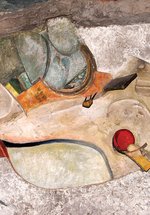The Loud and the Soft Speakers
Heather Ross presents this contemporary iteration of Kurt Schwitters’ almost lost performance piece 'The Silence Poem'.
/https://s3-eu-west-1.amazonaws.com/atwam-images-files/production/images/content/hattongallery/2018-09/222513.jpg)
Dates
Until 11 May 2019 (historic exhibition)
About
Programmed to coincide with Exploding Collage (which exhibited at Hatton Gallery September 2018 - January 2019) artist Heather Ross presents The Loud and the Soft Speakers, a contemporary iteration of a performance work - The Silence Poem or Leise - by the avant-garde German artist, Kurt Schwitters.
Taking the form of an immersive two channel video, Ross’ work examines The Silence Poem as a work of creation and destruction, which Schwitters repeated across multiple sites, incorporating newfound material and environmental influences to generate something new each time. Notably, Schwitters performed and developed The Silence Poem in English whilst interned in the Hutchinson Camp on the Isle of Man during World War II.
The Loud and the Soft Speakers – filmed on the same site and featuring musician and performance artist Florian Kaplick – employs performance as an exploratory tool for the visualisation of some of the historical and environmental influences which contributed to Schwitters experience of internment, and subsequently the development of The Silence Poem.
The Loud and the Soft Speakers is the outcome of Ross’ practice-based research excavating the varied meanings of The Pointless Collage (also known as Untitled (with porcelain shard)), which Schwitters made a year before he commenced work on the Merz Barn.
This exhibition is part of the Schwitters Legacy programme at the Hatton, an annual series of exhibitions that each examine a different facet of Schwitters’ influence on modern and contemporary art and culture.
Read our interview with Heather Ross.
About the Exploding Collage Season
Exploding Collage is a season of exhibitions at the Hatton Gallery inspired by the idea that Kurt Schwitters’ Merz Barn Wall – on permanent display in the Hatton Gallery – is a work of genre exploding collage practice, applying Schwitters’ collage technique on an architectural scale.
Each exhibition in the Exploding Collage season explores how avant-garde artists of the early twentieth century expanded the notion of collage into immersive, often ephemeral, formats, with an emphasis on those whose radical practice has led to their contribution being less recognised in canonical histories of the medium. The exhibitions include, Exploding Collage, Gathering, and The Loud and the Soft Speakers.
About the Merz Barn Wall
The Merz Barn Wall is a fragment of an unfinished artwork created by German artist Kurt Schwitters in a Lake District barn between 1947 and the artist’s death in 1948. Made up of plaster, paint and found objects, the work is emblematic of Schwitters’ interdisciplinary ‘Merz’ practice, which applied the principle of collage to all areas of life, re-contextualising discarded material to create new meanings and forms, whether in poetry, music, sculpture or space.
The Merz Barn Wall is the largest surviving fragment of the four Merzbauten (Merz Buildings) Schwitters began work on. The first Merzbau, made in his apartment in Hanover, Germany, was destroyed by allied bombing in 1943. Parts of his second Merzbau, begun in his holiday home in Hjertøyain, Norway, still survive. His third Merzbau near Oslo was destroyed by fire in 1951.
About the curatorial approach
The Merzbauten’s history of erasure and rebuilding informs the curatorial approach of Exploding Collage, which recognises the heightened risk of radically different artistic practice becoming lost due to the difficulty of preserving and exhibiting it.
Alongside this recognition is an awareness of the dual erasure that often effects the work of pioneering female artists, many of whom have historically been overlooked or actively undermined due to their gender. For instance, many of Schwitters’ female contemporaries were excluded from exhibitions, omitted from fellow artists’ written accounts, not collected by museums, and had their contributions belittled by art historians.
The result is a history of twentieth century avant-garde practice which appears to be dominated by men, even though women’s work was some of the most radical.
Although progress is being made in art history, exhibitions and museums are especially susceptible to perpetuating these historical ‘blindspots’, as it is often impossible to exhibit work by these artists due to gaps in public collections. As such, Exploding Collage seeks to circumnavigate the exhibition’s traditional reliance on historical artworks and objects, instead operating through contemporary artists’ work which carries within it the influence of such avant-garde artists, and testifies to their continued relevance and valued legacy, which can persist independently of the objects themselves.




